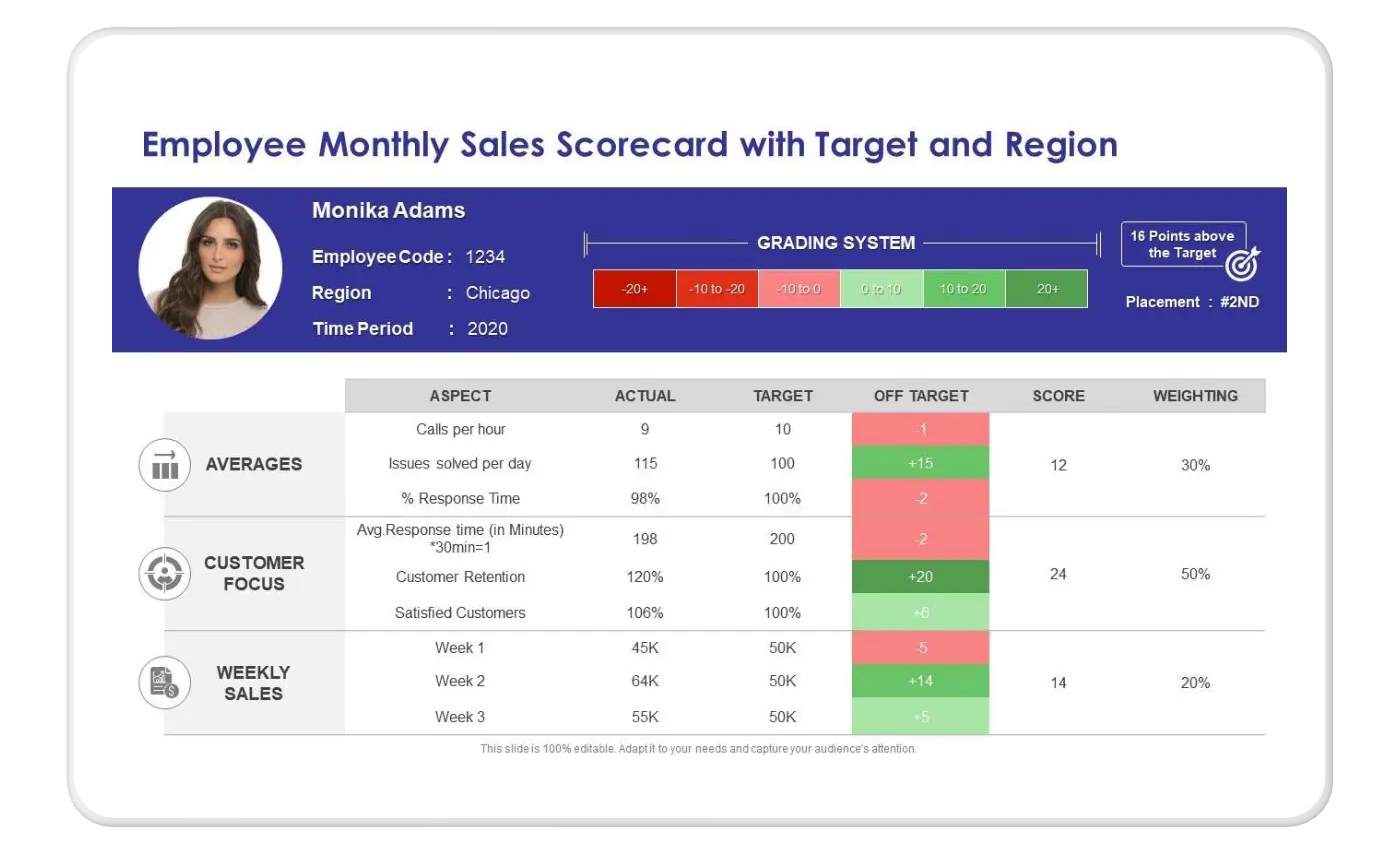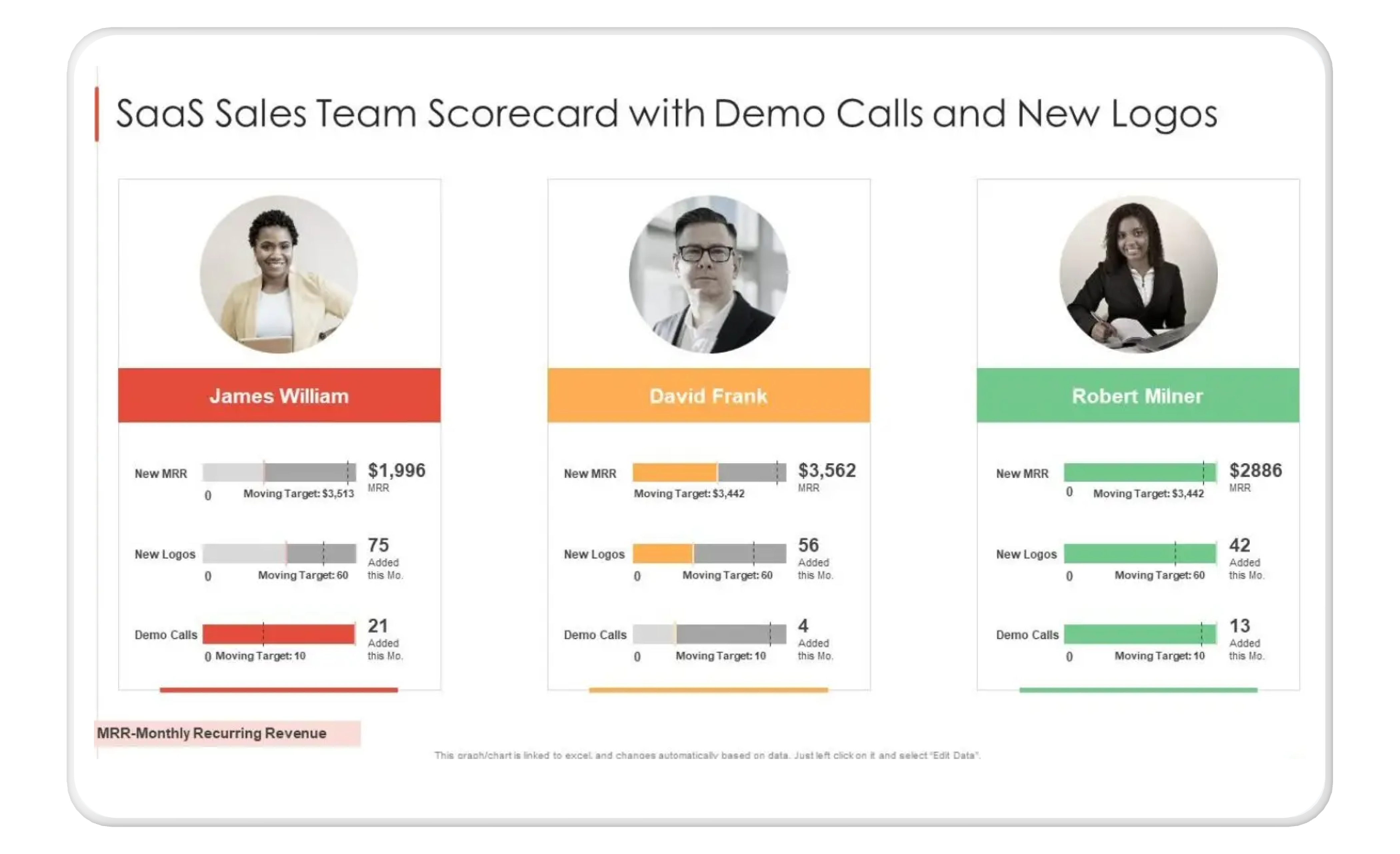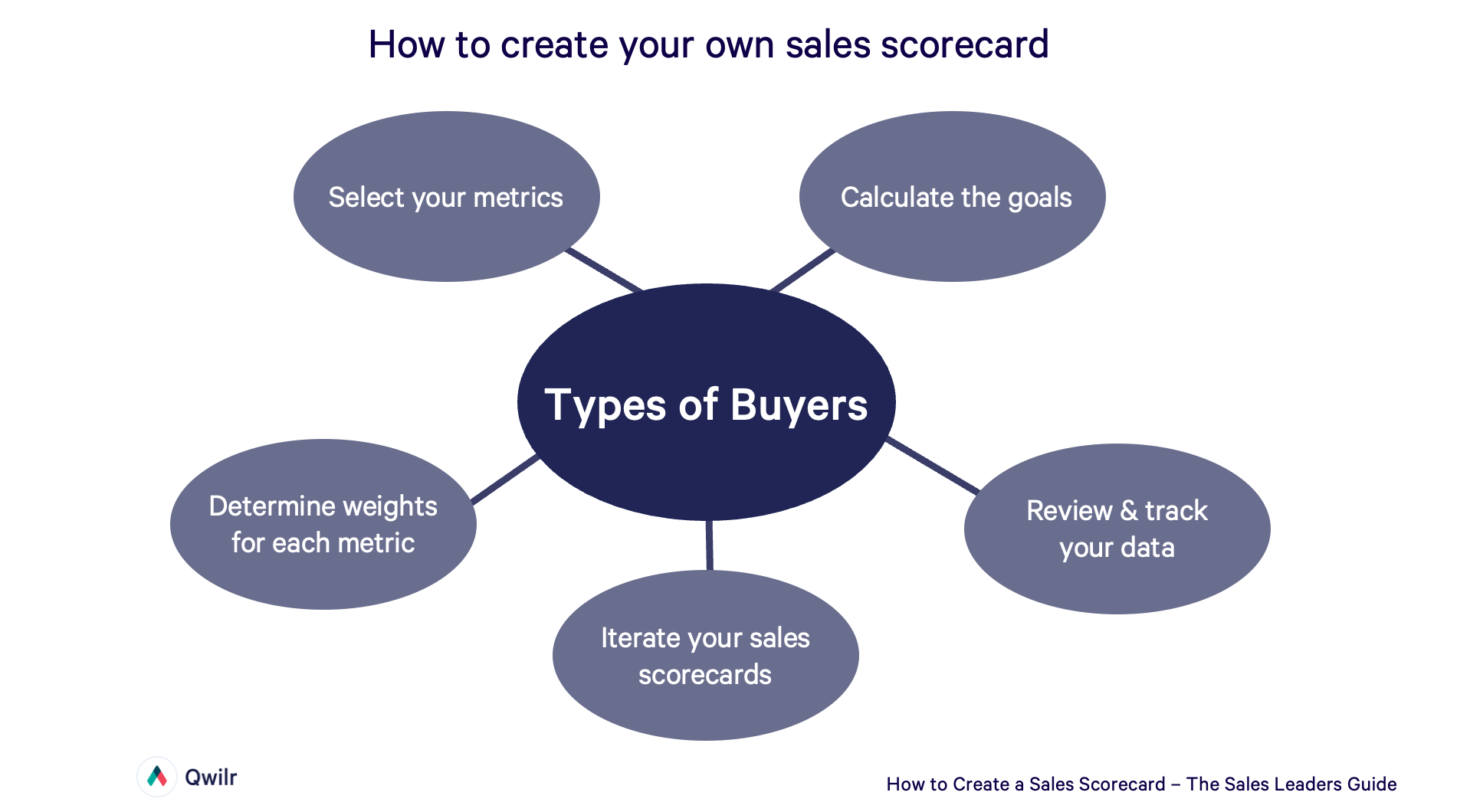In the sales world, we all love data. And lately, it feels like there's an app or sales dashboard to track everything - steps in the sales process, conversion rates, qualified opportunities, etc. As humans, we are continually seeking opportunities to know how we are doing and how we could be doing better.
So while the expression, what gets measured gets managed may be a cliche - it’s true. And as a sales leader, how do you ensure you and your teams track and manage the right things? Creating a sales scorecard can help clarify priorities and track results without overwhelming the sales team or trying to boil the ocean.
What is a sales scorecard?
A sales scorecard is a way to track sales rep performance and tie it specifically to the team’s development and goals. It gives you a method of tracking your salespeople’s historical results and measuring progress toward improvement.
Sales scorecards are excellent for keeping team members accountable, highlighting and rewarding top performers, and gamifying your processes to create healthy competition. The latter can be accomplished by creating a leaderboard using the details and data pulled into your sales scorecards.
Research shows that people who regularly set goals are likelier to achieve them. We see this in many areas outside sales, like athletic performance, personal finance, and budgeting. Getting specific and saying things, like I want to shave 20 minutes off my 10K time or save $5,000 for a vacation, are more likely to come to fruition. Saying something like “I want to run faster” or “I need to save money” is harder to quantify.
Beyond just setting individual goals, tracking sales activities leads to higher sales team performance which can impact the entire company or the business.
An excellent sales rep scorecard empowers your team to know where they stand against their personal and team goals and what they need to do to exceed them. This blog post will guide you through the steps to make a sales scorecard that drives results and helps everyone boost the bottom line in your organization.
Sales scorecard examples
While reading about a sales scorecard can be helpful, for visual learners, it’s time to look at some examples.
Individual contributor scorecard
Slide Team created this sales scorecard to show one employee’s monthly sales stats. It shows things like the average number of calls she makes in an hour and her average response time. The scorecard also shows the benchmarks she’s striving to achieve so that she can see how close she is and where she might need to adjust her sales performance each month.

SaaS sales team scorecard
This scorecard shows key performance indicators for members of the sales team. This can be helpful for sales leaders when comparing team members’ performances and used to inspire some healthy competition.

How to create your own sales scorecard
While it helps to see examples from others and there are many sales scorecard templates online, it’s important that your scorecard is made up of the right elements for your team.
A good scorecard should be iterative, so as you learn more from the data, you might what to adjust what and how you’re tracking, but you don’t want it to change so often that it’s ignored or sales team members feel like its the flavor of the week and that their efforts aren’t being tracked and rewarded.
Once you set up your scorecard, it might be worth finding out if you can automate the data population so your team can track progress in real-time if that’s possible (and if not in real-time maybe at least daily).
Use these simple steps to create the best scorecard for your sales organization.
Select your metrics
Performance metrics are different for every company, but they all have one thing in common: they drive your team. Make sure whatever you select for your scorecard is meaningful for your team, and each role has a scorecard reflecting their performance.
Avoid metrics for administrative tasks like updating the CRM or turning in sales reports where possible. While these items are part of your reps jobs, they’re not what’s moving the needle for your business.
Specific metrics like qualified leads, outbound calls, proposals sent, sales meetings, and deals won vs. lost can help you as a manager understand how people are spending their time and which activities are having the most impact.
Before selecting the metrics you want to include, get a baseline. Look at any sales KPIs you’re already tracking and determine the metrics most important to your business. This could look like any activity that helps boost your win rate. So, for example, if you know that meeting face-to-face (in person or over Zoom) boosts the likelihood of closing a deal by 30%, the number of face-to-face meetings in a time period might be a good thing to include on your scorecard to encourage reps to schedule more face time with customers.
Here are some questions to ask yourself when trying to determine which metrics to use:
- How are our reps performing? At their current pace, will they hit their goals?
- Is our team regularly improving their processes and performance?
- How are top performers closing sales?
- What are we doing to improve sales opportunities?
- Do we generate enough leads?
- Are we qualifying leads well enough?
From there, determine metrics you can include on your scorecards to help you answer these questions moving forward. Try to choose three leading indicators, one lagging indicator, and quality and quantity indicators to ensure a well-rounded report.
For leading indicators, you might select something like leads or sales conversations. At the same time, lagging indicators may be opportunities won or lost. The leading indicators funnel upwards to the lagging indicators, which are essential for indicating your team's future and current health.
For instance, a scorecard for someone in sales development (SDR/BDR) might include call volume numbers and sales accepted opportunities. Conversely, an account executive (AE) scorecard might consist of meetings, demos, or closed-won.
Calculate the goals
Don't set your goals arbitrarily once you’ve determined what key metrics you’ll have on your scorecard. Take numbers you already know and work back from them. For instance, if one of your metrics is the number of calls, take your company KPIs that involve calls and track them backward.
Say your goal for the quarter is $10 million, and the average deal size for your team is $1 million. To hit that number, your team will need to close ten deals. If your team closes about a quarter of the proposals they send out, you'll need to send 40 proposals to hit your goal.
To take it further, if you know one out of five prospects gets to the proposal stage, that means you need 200 prospects in the quarter. If you also know every ten phone calls results in one meeting with a prospect, then your reps should make 2,000 calls this quarter to hit your goals. That's one of the bottom-level goals you should set for your team.
From there, you must determine how to slice it across roles. For instance, some metrics should roll up to your managerial team. If you have ten reps, they should make 200 calls per quarter. If each sales manager is responsible for five reps, they should have 1000 calls per quarter on their scorecard.
Setting realistic goals helps your team feel fulfilled in their accomplishments and know precisely where to focus their efforts.
Determine weights for each metric
Not every metric should be tracked equally when it comes to sales scorecards. You’ll want to give more emphasis, and “weight” to the activities that move the needle most for your sales team.
So, for example, if you’re looking at outbound calls, demos, and proposals - the deals that get to the formal proposal stage are the most valuable - they’re weighted higher on the scorecard. Then, you have demos as the next most important activity; since you know demos often lead to formal proposals so they’re weighted in the middle. And, finally, you have your outbound calls. You know your team is averaging 20 outbound calls leading to one demo - so those are weighted the lowest on your scorecard since they are less likely to lead to closed deals.
Review & track your data
As data flows into the scorecard, you want to review and track it to understand what is going on in your sales team; for sales managers who have direct reports, a great time to look at an individual’s scorecard and metrics is during 1:1 meetings. Having time to discuss progress against the scorecard at a micro level lets sales leaders coach reps to make incremental changes that can lead to significant results.
Sales leaders should also look at the data for each rep at a higher level, like quarterly, and take some averages to understand how the team is doing overall. For example, one of the metrics on your scorecard is the number of proposals sent out each week. Understanding how the team (and each rep) is performing is helpful.
If you find that the goal is four proposals per week, Rep A is doing five, and Rep B is only getting three, you might also want to look at the average across the entire team. If the average is 3.5, maybe ask Rep A to coach Rep B until their weekly proposal count is up to 4 per week.
Iterate your sales scorecards
Creating a sales scorecard isn’t a one-time activity. You want to iterate and improve your scorecard by removing goals or activities that don’t provide value and adding those that do. You shouldn’t update your scorecard too often, which will lead to change fatigue. We recommend reviewing the scorecard items each quarter and noting what you might want to change on the sales scorecard in the next fiscal year.
If there is a major change in your market, competition, or some significant event that necessitates updating the scorecard mid-year, go ahead and make those changes - but, be sure that you and any sales managers with direct reports provide a clear and thorough explanation of the change to the scorecard and how it might impact performance evaluations and even compensation like commissions and bonuses.

Start improving your sales teams performance
You can find and use all the templates you want, but a scorecard will be more meaningful if it is custom-fit to your team. Using the tips in this article, start by choosing the metrics that are meaningful for each function on your team.
Calculate goals that funnel up to those metrics in qualitative and quantitative ways. Finding a balance between leading and lagging indicators also gives you a full picture of the team's overall performance.
Pick a place to host the cards that makes sense for your team. A visual reminder of the key focus areas is powerful - whether you’re all in the office together or working remotely.
If one of your metrics is around sending collateral or proposals or even speeding up the contracting process, Qwilr can help. Our online proposal software allows sales teams and reps to create templates for many key sales documents that are easy to customize and send out. Another benefit to using Qwilr for these tasks is that our robust analytics capabilities can give you great data for your sales scorecard. Want to see it in action? Check out our template library or schedule a demo today!
About the author

Marissa Taffer|Founder & President of M. Taffer Consulting
Marissa Taffer is the Founder & President of M. Taffer Consulting. She brings over 15 years of sales and marketing experience across various industries to a broad range of clients.
FAQs
A sales scorecard is a personalized report for sales reps that shows their progress against productivity and quality metrics. These might include the number of daily calls, meetings, proposals sent, or presentations. The scorecard might show the reps number for the day, week or month, how it compares to the benchmark set by the sales leader, and how it compares to other sales reps on the team.
In general, the things that make a good sales scorecard are metrics that will help your team excel in their sales efforts. For example, tracking the number of calls a rep completes only matters if they’re calling prospects who could actually convert. Holding sales reps to a number of calls to qualified prospects each day and tracking that activity through the scorecard will actually move the needle.


